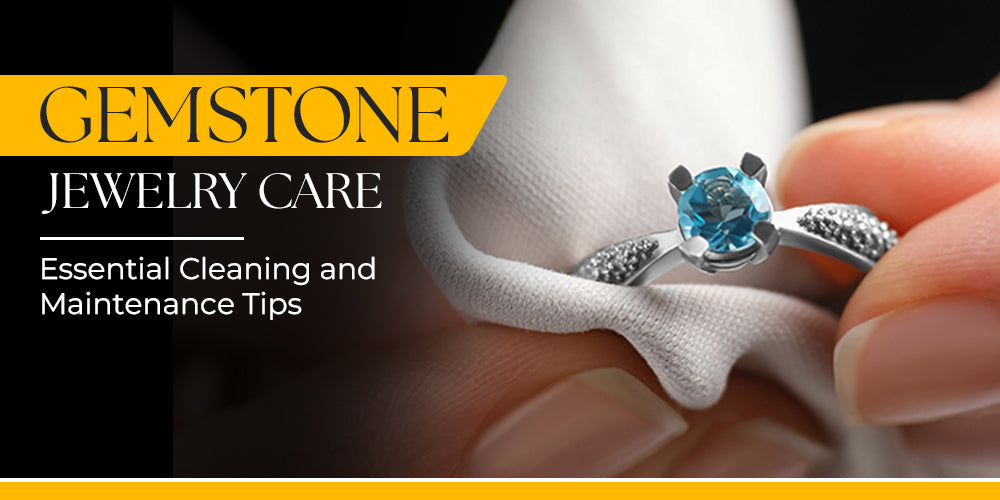Gemstone jewelry is more than just an ornament; it often represents personal milestones, celebrations, and memories. To keep these pieces in good condition, proper cleaning and care are essential. Since gemstones vary in hardness and sensitivity, the right care routine ensures that each piece retains its shine and stays secure in its setting.
Understand Your Gemstone
Not all gemstones are the same. Some, like sapphires and rubies, are hard and more resistant to scratches. Others, such as Tanzanite, Aquamarine, or Morganite, are softer and need extra attention. Knowing the hardness and sensitivity of your gemstone is the first step in protecting it. This understanding will guide you in choosing the right cleaning method and in handling the piece safely during daily wear.
Daily Handling and Protection
Simple habits can make a significant difference in the life of your jewelry. Always remove your gemstone pieces before applying lotions, perfumes, or hairsprays, as chemicals can damage both stones and metals. Avoid wearing jewelry during swimming, workouts, or household cleaning, since chlorine, sweat, and accidental knocks can cause long-term harm.
It is also wise to keep gemstones away from prolonged sunlight or sudden temperature changes. Some stones may lose color or even fracture when exposed to such conditions.
Cleaning at Home
Most gemstone jewelry can be cleaned at home with a straightforward method. Use lukewarm water mixed with mild soap, and gently scrub the jewelry with a soft toothbrush or lint-free cloth. Rinse well to remove soap residue, and dry the piece with a soft cloth. Avoid air-drying, as it can leave water spots.
Be cautious with ultrasonic or steam cleaners. While they may be safe for harder stones like diamonds or sapphires, they can damage softer gems such as Tanzanite, Emerald, or Morganite. When in doubt, stick to soap, water, and a gentle touch.
Caring for Metal and Plating
The metal setting is just as important as the gemstone itself. Many gemstone pieces are set in gold or rhodium-plated metals, each of which requires specific care.
-
Rhodium-plated jewelry (often used in white gold): Avoid abrasive cleaning methods and harsh chemicals, as these can wear down the plating. Over time, re-plating may be required to restore the finish.
-
Gold jewelry (yellow, rose, or white): Clean with mild soap and water, then dry and polish with a soft cloth.
-
Silver alloys: Store in a dry place to reduce tarnish, and clean gently when necessary.
Storage Guidelines
Proper storage prevents scratches and tarnish. Keep each piece in a separate pouch or compartment of a lined jewelry box. Softer gemstones should be wrapped in a soft cloth for extra protection. Always store jewelry in a cool, dry place away from sunlight and humidity to maintain both the gemstone and the metal setting.
Inspection and Professional Maintenance
Even with careful handling, gemstone jewelry benefits from regular checks. Inspect prongs, clasps, and settings to ensure stones are secure. If you notice movement, take the piece to a jeweler immediately.
Professional cleaning and inspection are recommended, especially for jewelry that is worn often. Jewelers can also advise when re-polishing or re-plating is needed to maintain the original appearance.
If Damage Occurs
If a gemstone becomes loose, scratched, or chipped, stop wearing it immediately. Store it securely and take it to a professional jeweler for repair. Avoid attempting home fixes, as they may cause further damage.
Final Thoughts
Gemstone jewelry is meant to be enjoyed, but it requires consistent care to stay beautiful and secure. By handling pieces carefully, cleaning them properly, storing them correctly, and seeking professional maintenance when needed, you can ensure that your jewelry lasts for many years.
Blue Star Gemstones’ Perspective
At Blue Star Gemstones, every piece is crafted with natural gemstones that carry unique character and value. We believe jewelry should be cherished for a lifetime, and proper care plays an important role in that journey. Whether it is Tanzanite, Aquamarine, Morganite, or other gemstones, understanding their nature helps preserve both their beauty and meaning.
We encourage customers to follow these care practices so their jewelry remains secure and brilliant through everyday wear and special occasions alike.
FAQ:
Q1: How often should I clean my gemstone jewelry?
A: Clean gemstone jewelry as needed, depending on how often you wear it. For regular wear, a gentle cleaning once a month is good. Deep cleaning and professional inspection every 6-12 months is helpful.
Q2: What cleaning methods are safe for soft gemstones like Tanzanite or Morganite?
A: Use lukewarm water, mild soap, and a soft toothbrush or lint-free cloth. Avoid ultrasonic or steam cleaning for softer stones, as they can crack, chip, or lose color.
Q3: Can I wear my gemstone jewelry while swimming or using household cleaners?
A: It’s better to remove gemstone jewelry before swimming, using cleaning chemicals, or doing heavy work. Chlorine, salt water, and harsh chemicals can damage both stones and metal settings.
Q4: How should I store my gemstone jewelry to avoid damage?
A: Store each piece separately, use soft pouches or compartments in a jewelry box. Keep jewelry in a cool, dry place away from direct sunlight or temperature extremes to avoid color fading or damage.
Q5: When should I get my gemstone jewelry inspected by a jeweler?
A: If you notice loose settings, movement of stones, or visible damage. Even without visible signs, a professional check every 6-12 months is wise, especially for pieces worn often.
Q6: What care does rhodium plating need?
A: Avoid abrasive cleaners and harsh chemicals. Use gentle cleaning methods and cloths. Over time, the plating may fade or wear; re-plating by a professional will restore its finish.
Q7: Does heat or sunlight damage gemstones?
A: Some gemstones are sensitive to heat, sunlight, or sudden temperature changes. Prolonged exposure can fade colours; thermal shock can cause cracks. Keep such stones away from strong light or heat.




